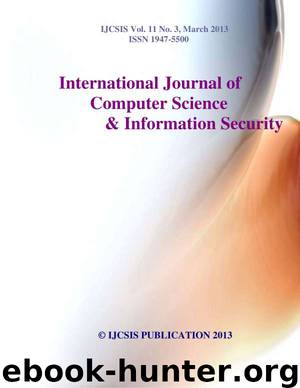Journal of Computer Science and Information Security IJCSIS March 2013 by ijcsis

Author:ijcsis
Language: eng
Format: epub
Tags: IJCSIS; call for paper; journal; computer science; research; google scholar; IEEE; Scirus; download; ArXiV; library; information security; internet; peer review; scribd; docstoc; cornell university; archive; Journal of Computing; DOAJ; Open Access; March 2013; Volume 11; No. 3; Impact Factor; engineering; international; proQuest; computing; computer; technology
CPU lime(s) -Best progra-n size Best Prograri fitress
V V to- -V <V <y
Fig. 2: Line graphs interpretation of Boolean 6-multiplexer
200
ISO
140 L20
SO GO
20
0
-CPU Time (s) -Best prograr size Best Prograr fitness
* v -v •>}■ fr- <v to r "V %• <=»• %
Fig. 3: line graphs interpretation of Boolean 11-multiplexer
VI. DISCUSSION AND FINDINGS
When the Boolean 6-multiplexer function and Boolean 11-Multiplexer function were executed against the preparatory requirements using our proposed algorithm, very impressive results were obtained. In the Boolean 6-multipler function, at various interval of run, the program size increased steadily as evolution progresses indicating a sign of code bloat, but after certain level of run, the program size dropped considerably as program fitness increases. The Boolean 11-multiplexer function also displayed almost the same behaviour; except that it exhibited better performance than the Boolean 6-multiplexer result in terms of better program size reduction. To this extent, it performed better in bloat control. This is in line with the 'No-free lunch' theorem that states that there is no single algorithm that provides omnibus solution to all problems.
VII. CONCLUSIONS
This paper Proposed a new method of code bloat control algorithm known as the DK-PC algorithm that Delete lower and Keep higher Fitness value Programs after Crossover. This algorithm was tested against the Boolean 6-multiplexer and Boolean 11-mutiplexer functions, and we observed that the algorithm was able to control bloat to a large degree. However, the algorithm performed better in the Boolean 11-multiplexer function than in the Boolean 6-multiolexer function. It is therefore clear to us that bloat is inevitable, but what extent can it be control? Our algorithm has considerably reduced code bloat to the barest minimum. Our advice for further research is that, other benchmark problems like artificial ant problem, symbolic regression problems and so on can be used to further test the efficacy of this algorithm.
80
http://sites.google.com/site/ijcsis/ ISSN 1947-5500
(IJCSIS) International Journal of Computer Science and Information Security, Vol. 11, No. 3, March 2013
REFERENCES
[I] E. Alfaro-Cid, A. Esparcia-Alcazar, K. Sharman, F. Fernadez [19] de Veg, and J. J. Merlo (2008), "Prune and plant: A new control method for genetic programming," Eighth International conference on Hybrid Intelligent Systems. IEEE doi [20] 10.1109/HIS.2008.127
[2] P. J. Angeline (1997), "Comparing subtree crossover with
macromutation," In Proceedings of the Sixth International [21]
Conference on Evolutionary Programming, 1213, 101-111, Indianapolis, USA.
[3] S. Bleuler, M. Brack, L. Thiele, and E. Zitzler [22]
(2001),."Multiobjective genetic programming: Reducing bloat using SPEA2," In Proceedings of the 2001 Congresson Evolutionary Computation CEC2001, pp 536-543, COEX, [23]
World Trade Center, 159 Samseong-dong, Gangnam-gu, Seoul, Korea: IEEE Press.
[4] D, S. Burke, K. A. De Jong, J. J. Grefenstette, R. Crawford-
Marks, and L. Spector (2002), "Size control via size fair [24]
genetic operators in the pushGP genetic programming system," Proceedings of the Genetic and Evolutionary Computation Conference, GECCO-2002, San-Francisco, CA: Morgan Kaufmann. [25]
[5] K. Chellapilla (1997), "Evolving computer programs without
using subtree crossover," IEEE Transactions on Evolutionary Computation, 1(3):209-216. [26]
[6] C. Darwin (1996), " The origin of species. Oxford, UK: Oxford
University Press.(Original work published in 1859).
[7] E. D. de Jong, R. Watson, and J. Pollack
Download
This site does not store any files on its server. We only index and link to content provided by other sites. Please contact the content providers to delete copyright contents if any and email us, we'll remove relevant links or contents immediately.
Whiskies Galore by Ian Buxton(41879)
Introduction to Aircraft Design (Cambridge Aerospace Series) by John P. Fielding(33064)
Small Unmanned Fixed-wing Aircraft Design by Andrew J. Keane Andras Sobester James P. Scanlan & András Sóbester & James P. Scanlan(32743)
Aircraft Design of WWII: A Sketchbook by Lockheed Aircraft Corporation(32214)
Craft Beer for the Homebrewer by Michael Agnew(18140)
Turbulence by E. J. Noyes(7936)
The Complete Stick Figure Physics Tutorials by Allen Sarah(7307)
The Institute by Stephen King(6936)
Kaplan MCAT General Chemistry Review by Kaplan(6867)
The Thirst by Nesbo Jo(6828)
Bad Blood by John Carreyrou(6552)
Modelling of Convective Heat and Mass Transfer in Rotating Flows by Igor V. Shevchuk(6391)
Learning SQL by Alan Beaulieu(6211)
Weapons of Math Destruction by Cathy O'Neil(6146)
Man-made Catastrophes and Risk Information Concealment by Dmitry Chernov & Didier Sornette(5921)
Permanent Record by Edward Snowden(5738)
Digital Minimalism by Cal Newport;(5664)
Life 3.0: Being Human in the Age of Artificial Intelligence by Tegmark Max(5474)
iGen by Jean M. Twenge(5366)
